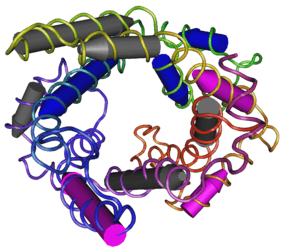Uncoupling protein

An uncoupling protein (UCP) is a mitochondrial inner membrane protein that is a proton channel or transporter. An uncoupling protein is thus capable of dissipating the proton gradient generated by NADH-powered pumping of protons from the mitochondrial matrix to the mitochondrial intermembrane space. The energy lost in dissipating the proton gradient via UCPs is not used to do biochemical work. Instead, heat is generated. This is what links UCPhermogenesis. UCPs are positioned in the same membrane as the ATP synthase, which is also a proton channel. The two proteins thus work in parallel with one generating heat and the other generating ATP from ADP and inorganic phosphate, the last step in oxidative phosphorylation.[1]
There are five types known in mammals:
- UCP1, also known as thermogenin
- UCP2
- UCP3
- SLC25A27, also known as "UCP4"
- SLC25A14, also known as "UCP5"
Uncoupling proteins play a role in normal physiology, as in cold exposure or hibernation, because the energy is used to generate heat (see thermogenesis) instead of producing ATP. However, other substances, such as 2,4-dinitrophenol and carbonyl cyanide m-chlorophenyl hydrazone, also serve the same uncoupling function, and are considered poisonous. Salicylic acid is also an uncoupling agent and will decrease production of ATP and increase body temperature if taken in excess.[2] Uncoupling proteins are increased by thyroid hormone, norepinephrine, epinephrine, and leptin.[3]
References
- ↑ Nedergaard J, Ricquier D, Kozak LP (2005). "Uncoupling proteins: current status and therapeutic prospects". EMBO Rep. 6 (10): 917–21. doi:10.1038/sj.embor.7400532. PMC 1369193
 . PMID 16179945.
. PMID 16179945. - ↑ "California Poison Control System: Salicylates".
- ↑ Gong DW, He Y, Karas M, Reitman M (1997). "Uncoupling protein-3 is a mediator of thermogenesis regulated by thyroid hormone, β3-adrenergic agonists, and leptin". J Biol Chem. 272 (39): 24129–32. doi:10.1074/jbc.272.39.24129. PMID 9305858.
External links
- Uncoupling Agents at the US National Library of Medicine Medical Subject Headings (MeSH)